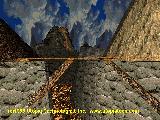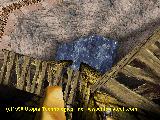

History: Sequel to original game called Montezuma’s Revenge which was originally released over 17 years ago for the Atari 800 and Commodore 64 and sold over 600,000 copies. The game as originally released was a platform game, such as Jumpman, Lode Runner, Miner 2049’er, Mario, or Sonic.
Montezuma's Revenge was a top-5 game on almost every platform. It set the standard for platform games for years. That kind of success screams for a sequel. The sequel will not be another platform game, but a Doom-clone with a twist.
Plot: Max Montezuma is a soldier decended from an ancient Aztec emperor. Max stumbles across a deserted, uncharted island, and conveniently crashes his plane on it. On this as yet undiscovered, prior to Max’s getting there, island, Max only has a flashlight, canteen, and an entire lost Aztec civilization, and restore the desecrated tomb of his ancestors all into the collective coincidental bargain. Max must discover the link between the ancient Aztecs and an alien race of saucer flying mystery. Well its not really a civilization since all the people are dead or are they?
Locations to explore: 500 indoor and outdoor scenes combine with over 150 animated polygonal models of monsters like a large spyder and bird. You will need to avoid obstacles to be sucessful in this game. Your character has to learn how to climb ropes.
Game play: The designers were attempting to put the feel and magic of the original game into a three dimensional shooter or first person action games. By using some of the elements seen in the previous game, updated to the three dimensional shooter of today, Montezuma's Return will retain some of the sparkle of the prequil. You will see bouncing skulls, snakes, spiders and other characters from the original game.
Puzzles: What will separate this game from the Doom-clones is the 3D and platform puzzle-solving features. Max must learn to climb ropes, use trampolines and trapeze-type devices to avoid traps and fire pits. In some ways Montezuma's Return is like Tomb Raider. Players will have to navigate moving platforms, elevators, morphing walls, and mechanical traps all designed with an advanced physics engine not like any seen before.
Not all the puzzles are physical. There is a quick and deadly lobster that you cannot avoid or beat in combat, but if you can figure out how to divert a lava stream you can steam your crustation into submission. Rescue the giant frog from the well and he becomes your ally and teaches you to jump farther than you could before, which will allow you to reach areas previously beyond your abilities.
Size: The game will be comprised of over 30 differerent areas divided in seven major areas or four or five levels each. Each area will be nonlinear, and there will be multiple solutions to get from one area to another, just to make the game play differently the second time around.
Characterization: Friendly and threatening real-time 3D animated characters and aliens.
Humor: The game is expected to have a humorous element, such as hysterical plot twists

Graphics: are multiple, high-resolution 65,000 color graphics. The object modeling takes into account physics, such as gravity, reflection, air, and other features. The game is true 3D with movement in six degrees of freedom. Optional Fast Phong- and Gouraud shaded, perspective-mapping, light-sourcing, real-time shadows, bump mapping, z-buffering, MIP mapping and other things combine with multiple movable point and spotlight light sources, view ports, and cameras to make the graphics an outstanding visual treat. Weather effects and underwater sequences will add to the visual feast.
Some rendered characters have as many as 500 polygons worth of detail to describe them. Every character, including your enemies and friends will be modeled in three dimensions. Now 2D sprites will be used in the game. Special "low-polygon viewer-oriented models" will be used to preserve the sprite level of detail but avoid using two dimensional sprites. Phonf shading, multiple movable light sources, subtile lighting effects, morphing and scaling characters and rooms, chrome and reflection mapping, and some special proprietary effects make the graphics special.
Resolution for the game is at 800x600 pixels standard. Most textures are 128x128 pixeels. The game supports 256-colors and 64K color mode for photorealistic graphics.
Animation: The graphics accelorators are supported including Verete' based accelorators, 3Dfx, PowerVR and MMX. The game will run with a standard graphics card, as well.
Physics: Special surface attributes supported include sticky, slippery, and bouncy surface forces. Texture mapping with support optional quick perspective, animated, scrolling, turbulent, and opaque multiple resolution textures, with edge smoothing. Advanced forward kinematics simulation of rigid body motion will simulate wind, gravity, and surface friction. An analytic collision detection and resolution system will work within a realtime environment with a realtime dynamic constraint solver and multi-joint inverse kinematic simulation.

Other features we do not pretend to understand include hierarchical, linked models, 3D model scaling and deformation effects, multple instancingof objects and hierarchies, fog and darkness depty cuing, and stereoscopic capability. Youcall them and ask them what all this means and explain it to the rest of us.
Sound: An original soundtrack with 3D sourced sound effects is planned.
Multiplayer: Montezuma's Return is currently a single player action adventure game with networking features planned for the future.

References:
Steve Bauman, Computer Games Strategy Plus, number 70, pg. 14
Andrew Sanchez, Boot, volume 2, number 8, pg. 73.